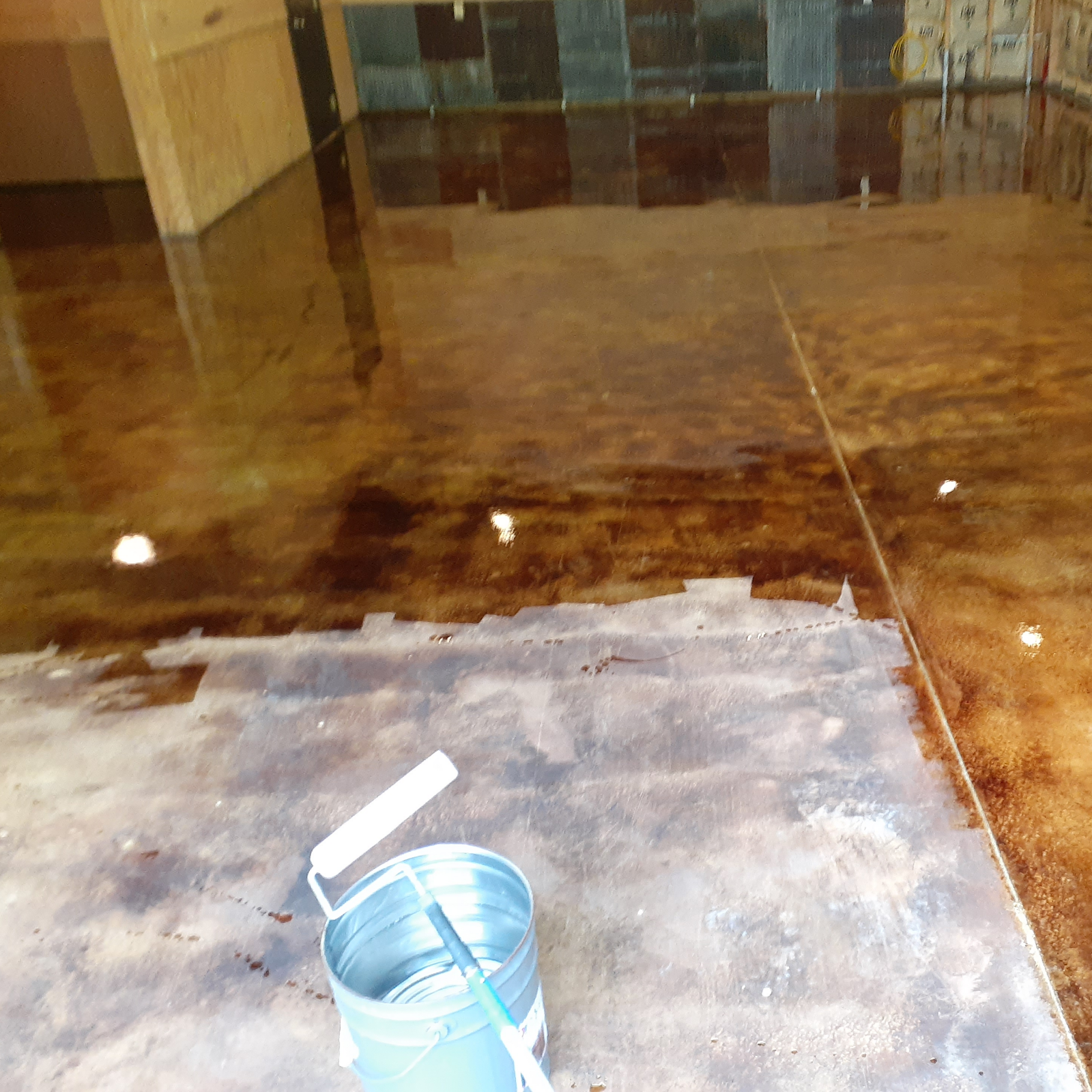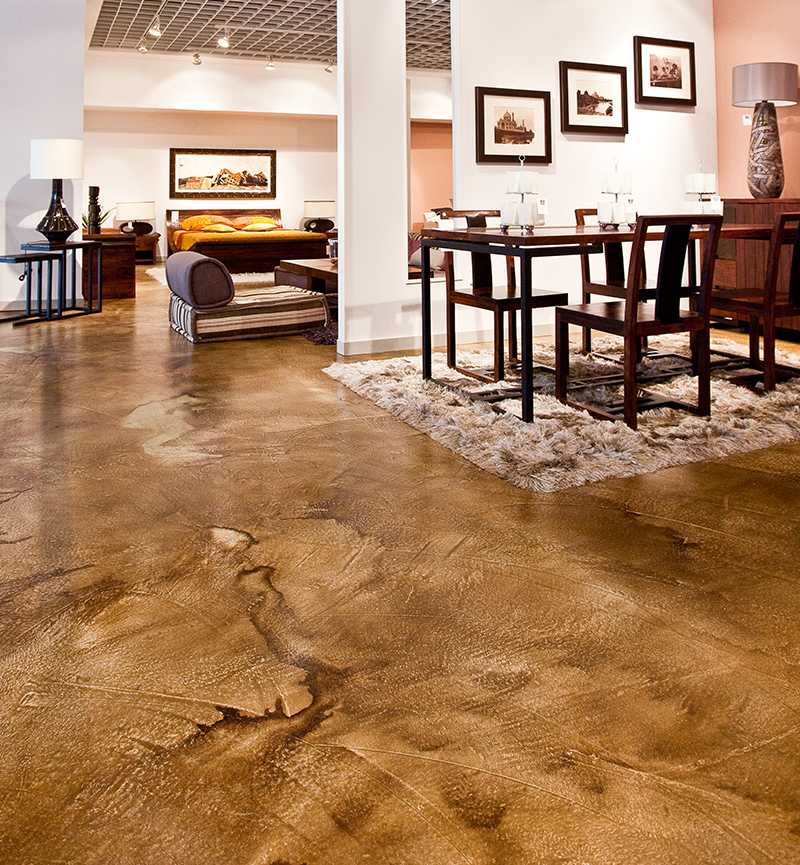Smart ideas to use local stained concrete in kitchens
Everything About Stained Concrete: A Comprehensive Overview to Its Advantages and Applications
Stained concrete has become a popular option for both household and commercial spaces. Its capability to integrate visual charm with practicality makes it an interesting choice. Different staining methods use an array of colors and finishes, enabling personalization. The advantages expand past appearance. Understanding its applications and upkeep demands is crucial for any individual considering this versatile material. The subtleties of stained concrete invite further exploration.
What Is Stained Concrete?

Discoloration can be related to numerous surfaces, including floorings, driveways, and patio areas, making it a functional alternative for both indoor and outdoor areas. The treatment can achieve a series of appearances, from natural tones to strong, contemporary styles. Unlike paint, stained concrete keeps its look gradually, as it ends up being an indispensable component of the concrete itself. On the whole, stained concrete offers as a reliable method for transforming common concrete into aesthetically striking surfaces.
Advantages of Stained Concrete
Stained concrete deals considerable advantages, especially in aesthetic allure and durability - local stained concrete. Its vivid shades and one-of-a-kind patterns improve the visual charm of any space, making it a preferred selection for both domestic and commercial applications. Additionally, the durability of stained concrete assurances that it stays a sensible financial investment in time, standing up to wear and tear
Aesthetic Allure
One of one of the most engaging advantages of using stained concrete is its amazing visual appeal. Stained concrete deals an unique and versatile look that can enhance different style styles, from modern to rustic. The mixture of vivid shades and complex patterns permits house owners and designers to produce personalized surfaces that can improve the total atmosphere of a space. Unlike standard floor covering choices, stained concrete can resemble the appearance of all-natural rock or sleek marble, offering an upscale look without the connected expenses. Additionally, the glossy coating alternatives can show light, additional brightening insides. This versatility makes stained concrete a preferred choice for both property and industrial applications, where aesthetic influence is critical.
Durability and Long life
The impressive aesthetic high qualities of stained concrete are enhanced by its amazing sturdiness and long life - stained concrete company. Stained concrete surface areas are immune to deterioration, making them appropriate for high-traffic areas both inside your home and outdoors. Their durable nature indicates they can stand up to extreme weather, including extreme temperatures, rain, and UV exposure, without significant deterioration. Furthermore, stained concrete needs marginal upkeep contrasted to various other flooring options, as it does not need regular sealing or refinishing. This long life not just lowers substitute prices however likewise adds to a sustainable building approach. Overall, stained concrete offers an enduring remedy that incorporates aesthetic appeal with sensible benefits, ensuring its value gradually
Various Types of Staining Techniques
Different staining methods can significantly affect the aesthetic high qualities of concrete surface areas. The three key techniques include acid discoloration, which responds chemically with the concrete, water-based staining, which uses a wider variety of colors, and overlay staining options that give a fresh surface area. Each technique has one-of-a-kind characteristics and applications that cater to numerous layout preferences and project needs.
Acid Staining Approach
How can home owners transform plain concrete surface areas into visually striking functions? One effective approach is acid staining, a preferred method that improves the all-natural charm of concrete. This procedure involves applying a solution of water, hydrochloric acid, and metal salts to the concrete surface area. As the acid responds with the lime present in the concrete, it develops rich, variegated colors that look like marble or rock. Acid staining is understood for its sturdiness and resistance to fading, making it a long-lasting option for both indoor and exterior applications. Nevertheless, it is necessary to keep in mind that the results can vary based on the original concrete color and appearance - stained concrete company. Appropriate application and securing are vital for accomplishing the wanted visual and longevity
Water-Based Staining Technique
A prominent option to acid staining, the water-based discoloration strategy supplies property owners a functional way to boost concrete surface areas. This approach utilizes water-soluble dyes and pigments, permitting for a wide variety of colors and finishes. Unlike acid spots, water-based spots can be related to unsealed concrete and use a simpler cleanup process. The outcomes can accomplish a more uniform appearance and can be layered to produce unique effects. In addition, water-based spots are typically less harmful and release less unpredictable natural substances (VOCs), making them a lot more ecologically pleasant. Home owners might appreciate the capability to customize their concrete surface areas with various shades, allowing for imaginative expression while keeping durability and durability in their flooring choices.
Overlay Discoloration Options
Various overlay discoloration choices exist for home owners wanting to revitalize their concrete surface areas. One popular option is acid staining, which responds chemically with the concrete to generate abundant, read variegated shades. One more option is water-based staining, offering a more comprehensive color palette and less complicated application. Additionally, concrete overlays can be integrated with patterns for complex layouts, enhancing aesthetics. For a much more textured coating, property owners might consider using stamped overlays that resemble natural materials like rock or ceramic tile. Each method provides distinct benefits, from longevity to personalization, permitting a customized touch. Eventually, the selection of overlay discoloration relies on the desired look and the problem of the existing concrete, making certain a refreshed and appealing surface.
Applications of Stained Concrete
Stained concrete offers a functional solution for various applications, improving both aesthetic allure and functionality. This material is generally utilized in domestic, industrial, and industrial settings, making it a prominent choice among architects and designers. In homes, stained concrete can work as trendy flooring or outside patio areas, giving an advanced appearance while remaining resilient.
In industrial areas, such as retail stores and dining establishments, stained concrete adds to a contemporary setting and can hold up against heavy foot traffic. In addition, stained concrete is significantly used in public rooms like parks and sidewalks, where its capability to imitate natural rock or various other materials adds visual passion.
Additionally, stained concrete is optimal for pool decks and driveways, offering a slip-resistant surface area that is simple to preserve. Generally, the adaptability of stained concrete makes it ideal for many environments, dealing with varied preferences and demands.
Upkeep and Treatment for Stained Concrete
Correct upkeep assures the durability and elegance of stained concrete surface areas. Routine cleansing is important; making use of a mild cleaning agent and water with a soft-bristle brush helps get rid of dirt and crud without damaging the finish. It is recommended to avoid extreme chemicals that can remove the discolor or sealant.
Securing stained concrete is essential for security versus wetness, discolorations, and use. A high-grade sealer must be reapplied every one to 3 years, relying on the web traffic and direct exposure the surface area withstands. In addition, dealing with spills without delay will stop discoloration and staining.

Cost Considerations for Stained Concrete Projects
When preparing a discolored concrete job, spending plan factors to consider play a necessary role in determining the total cost. The costs connected with stained concrete can differ considerably based on a number of elements. The dimension of the location to Check This Out be stained directly influences product and labor prices. Larger spaces will naturally require more sources. Second, the type of tarnish selected-- acid-based or water-based-- can impact rates, with acid stains commonly being more expensive. Furthermore, the complexity of the design, including patterns or multiple shades, can raise labor prices. Preparation work, such as cleaning and grinding the concrete surface, includes in the preliminary expenditures too. The option between Do it yourself installation and employing an expert specialist will certainly further impact the budget. Recognizing these variables makes it possible for property owners to make informed economic choices regarding their stained concrete projects, ensuring they attain the wanted visual within their economic ways.
Tips for Selecting the Right Stained Concrete for Your Space
Picking the right stained concrete for a details space entails cautious contemplation of different aspects beyond simply budget plan. First, one need to evaluate the designated use of the area. High-traffic zones may require even more resilient coatings, while ornamental applications can focus on aesthetic appeals.
The color scheme is one more essential element; the selected hues need to integrate with existing design and illumination. It's also vital to think about the surface area texture, as smooth surfaces can enhance refinement, while textured choices may assure safety and security in wet areas.
Neighborhood climate and ecological problems play a substantial role in the long life and maintenance of stained concrete, influencing the selection of sealants and surfaces.
Seeking advice from with specialists can supply important insights tailored to certain requirements, assuring the selection of the ideal stained concrete that straightens with both performance and style.
Often Asked Questions
Can Stained Concrete Be Applied Over Existing Floor Covering?
Stained concrete can indeed be applied over existing floor covering, offered the surface is secure and sufficiently prepared. This technique enables for a visual upgrade without the need for total elimination of the initial floor covering materials.
For How Long Does Stained Concrete Last?
Stained concrete can last for years when effectively kept. Aspects such as web traffic, ecological conditions, and application techniques greatly influence its long life, with several installations next page remaining lively and undamaged for 10 to thirty years.
Is Stained Concrete Slippery When Damp?
Stained concrete can be slippery when damp, as the finish might produce a smooth surface. Nonetheless, using non-slip additives or distinctive coatings can mitigate this concern, enhancing safety without jeopardizing the visual allure of the concrete.
Can I Discolor Concrete Myself, or Should I Employ an Expert?
The choice to tarnish concrete directly or employ an expert joints on ability level and job intricacy. While DIY discoloration can save cash, professionals guarantee optimal results, specifically for detailed designs or huge surface areas.
What Color styles Are Offered for Stained Concrete?
The range of colors readily available for stained concrete consists of natural tones like browns and tans, vibrant tones such as reds and blues, and softer tones like pastels. This scheme enables for innovative, personalized design choices.